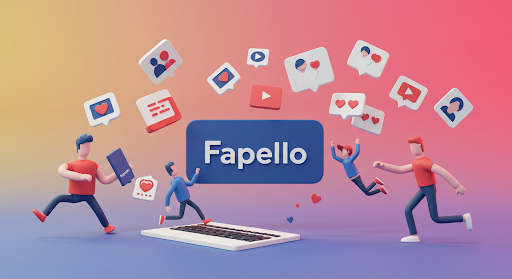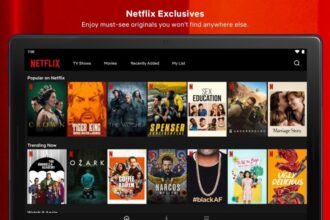Why are creators shifting toward niche platforms in 2025?
Let’s be real for a second. If you’re a content creator in the UK today, you’ve likely felt the pinch of overcrowded platforms. Between algorithm shifts, content suppression, and an ever-growing number of competitors, getting seen feels harder than ever. Even seasoned creators with a loyal audience have started asking, “Is there a space that actually supports what I do?” Whether you’re into short-form videos, exclusive photos, or micro-blogging, the search for a reliable, creator-first platform has become more than a trend—it’s a need.
That’s exactly where a rising platform like Fapello steps in. Especially in 2025, when content monetisation, ownership, and discoverability have all become front and centre in the creator economy, platforms built specifically for creators—not advertisers—are what people are turning to.
What makes a niche content-sharing platform valuable in 2025?
The biggest benefit? You own your audience. No more battling with shadow bans or confusing engagement dips that leave you guessing. Platforms like this are built to prioritize the people who put in the actual work: the creators.
Here’s what stands out the most:
- Direct connection with subscribers or followers
- Higher monetisation control with fewer middlemen
- Customisable profiles to reflect your brand
- Content ownership and transparent licensing rules
- UK-based platform compliance with GDPR and local digital media regulations
Not to mention, it’s designed to support all types of digital media—from photos and exclusive clips to behind-the-scenes stories.
How is creator content evolving on UK platforms?
Let’s talk about trends in real terms. In the last 18 months alone, the UK saw over a 22% rise in digital creators opting for platforms beyond Instagram or YouTube. Many now prefer platforms where algorithmic bias is less aggressive, and where discoverability doesn’t solely depend on paid promotions.
For instance, creators working in adult-themed content or niche lifestyle categories—who often face restrictions on mainstream social networks—find open-format platforms to be more inclusive. This includes everything from fitness coaching and cosplay photography to subscription-based storytelling and art.
In 2025, flexibility in content format and audience interaction isn’t just helpful—it’s essential.
What kind of content thrives on user-focused platforms?
You’ll see a wide mix. The following categories have seen a consistent rise:
- Lifestyle vlogging with exclusive updates and community polls
- Art and design portfolios shared as photo reels or zip archives
- Fitness guides in PDF or video formats
- Behind-the-scenes reels from modeling shoots
- Subscription-based stories, including erotic fiction and fantasy roleplay
- Tutorial content for photography, video editing, and makeup
These platforms encourage users to create content for their loyal community—not the masses. That changes how creators think, plan, and publish.
Are there any real-life examples of creators succeeding on exclusive content platforms?
Absolutely. Let’s take someone like Lily, a 29-year-old fitness instructor from Manchester. After years of putting out free content on Instagram with barely any monetisation, she switched to a platform that allowed her to create exclusive workout packages. Within 6 months, she saw consistent income and far better engagement.
Or Jamal, a London-based photographer. His behind-the-scenes photoshoots were often flagged on conventional platforms for “sensitive content.” With a more open content policy and privacy tools, he could post full collections with confidence—and saw his subscriber base grow 3x faster.
These aren’t rare cases. This is becoming the standard.
How important is privacy and safety on these content platforms?
One of the most frequently asked questions I hear from creators is, “How safe is it to share personal content online?” That’s a valid concern—especially in 2025, where data breaches and impersonation scams are all too common.
User-focused platforms now embed:
- Two-factor authentication as a default
- End-to-end encryption for private messages
- IP-based access controls
- Granular content visibility settings (like per-subscriber permissions)
- Copyright protection and takedown support
Many platforms also support watermarking tools for images and downloadable content, so creators can feel a bit more secure about sharing their work.
What monetisation options are available to UK creators?
Let’s talk about money. Because if you’re sharing content, your time deserves to be paid for.
Here’s a simple table outlining the common monetisation features:
| Feature | Availability | Notes |
| Subscriptions | Yes | Monthly or yearly tiers available |
| One-time purchases | Yes | Great for individual digital downloads |
| Tips & Donations | Yes | Optional for followers to support creators |
| Affiliate Linking | Limited | Some restrictions depending on content type |
| Ad Revenue | No | Most creator-first platforms do not run ads |
| Merchandise Store Integration | Yes | Especially useful for physical product sellers |
This shift—from ad-based models to direct payment—benefits both the creator and the audience.
Who actually uses these platforms in 2025?
Surprisingly, it’s not just influencers or full-time creators. The platform has seen growth in users like:
- University students sharing exclusive educational tutorials
- Niche bloggers offering paid guides
- Models and performers offering behind-the-scenes access
- Photographers and stylists creating subscriber-only reels
- Writers and adult fiction creators posting episodic content
This opens the door to multiple income streams for people who may have never considered themselves “influencers.”
How does it differ from Instagram or TikTok?
Great question. The short answer? Control and content depth.
Here’s what you typically get with mainstream platforms:
- Algorithm-dictated visibility
- Frequent content takedowns
- Minimal monetisation unless you have 500k+ followers
- Limited content formats
- Ad-first business model
Compare that with content-first platforms built for creator autonomy:
- Direct audience access
- Full control over pricing and distribution
- Long-form content freedom
- Privacy for both creator and subscriber
- Low algorithm interference
So instead of chasing virality, creators can focus on meaningful growth.
What tools and technology power these content-sharing platforms?
If you’re curious about what’s going on behind the scenes, the tech stack in 2025 has really stepped up. While you don’t need to be a software developer to benefit from it, understanding the tools used can help you make smarter decisions as a creator.
Some of the most important features run on:
- CDNs (Content Delivery Networks) to ensure fast media loading across the UK
- AI-powered moderation that actually understands context, unlike older flagging systems
- Advanced analytics dashboards that show where your traffic is coming from and what type of content performs best
- Blockchain verification for content ownership and traceability
- Mobile-first frameworks for creators who upload and manage their content from phones
For example, imagine you’re a visual artist sharing high-resolution files. These platforms now compress your content smartly without losing quality, thanks to intelligent compression layers built into their CDNs.
Why do micro-communities matter more than ever?
Back in the day, creators focused on reaching everyone. But that’s shifted. In 2025, building a niche, highly engaged audience beats going viral with strangers.
Here’s why micro-communities are more powerful:
- They’re more loyal, often converting into paying subscribers
- Engagement rates are consistently higher than those on mainstream networks
- Feedback is more relevant and actionable
- You spend less on ads and still grow
- Community members often help promote your content organically
Whether it’s a 500-member photography club or a few thousand fans of adult cosplay fiction, these smaller spaces feel more human. And that means creators can build genuine, long-term relationships with their audience.
How are UK regulations influencing content platforms in 2025?
Here’s where things get real. As of this year, the UK has reinforced multiple content laws under the Online Safety Act, GDPR updates, and Digital Services Regulations. These new regulations put pressure on platforms to:
- Make age-gated content more secure
- Offer transparent data tracking reports
- Provide manual review for flagged posts
- Maintain full compliance with copyright laws
- Give creators the right to request content takedown or ownership verification
This benefits you as a creator, because your work is now better protected under UK law. And if you’re a subscriber or fan, it means safer browsing, less spam, and clearer boundaries.
What are some of the most in-demand content types on UK-based platforms?
In 2025, content creation is more diversified than ever. Here’s a closer look at what’s trending among creators who use UK-based, community-driven content platforms:
- Cosplay sets with HD photo collections and transformation videos
- Daily vlogs with exclusive bonus clips
- ASMR and voiceover libraries available to subscribers
- Private photo albums for lifestyle and adult content creators
- PDF guides for niche skills like drone photography or fetish modeling
- Mini-courses delivered in weekly chapters
- Event access (like virtual meetups, private group chats, and behind-the-scenes lives)
Creators are also bundling their content creatively—for instance, offering a “starter pack” for new fans that includes a welcome video, photo set, and personal thank-you note.
What are the biggest challenges creators face on these platforms?
No platform is perfect, and creators still face some hurdles, especially when transitioning from mainstream apps. Here’s what many have reported:
- Learning curve: The dashboards and tools take time to get used to
- Audience migration: Moving followers over from Instagram or TikTok takes effort
- Payment delays: Although rare, they can happen depending on the payment provider
- Content theft: While platforms offer protection, piracy remains a problem online
- Platform rules: Every site has its own set of community guidelines and restrictions
That said, many of these challenges are short-term. Once a creator gets the hang of the new system and builds an audience, the long-term benefits tend to outweigh the hiccups.
How do platforms support creators beyond content hosting?
Surprisingly, many content-focused platforms are doing more than just hosting your work—they’re helping you grow as a brand. Here’s how:
- Mentorship programs: Pairing new creators with experienced ones
- Affiliate programs: Letting creators earn by referring others
- Integrated email campaigns: Helping you send newsletters to your fanbase
- Workshops and community forums: Where you can exchange tips with others
- Customer support that’s actually responsive—most offer live chat in the UK timezone
For instance, if you’re a UK-based content creator just starting out, you might be invited to a monthly Zoom Q&A where creators discuss everything from subscriber management to lighting setup.
What kind of creators should consider joining?
To keep it simple—if you’re producing digital content and want more control, you’re the right fit.
These platforms are perfect for:
- Adult content creators who need a safe, private space
- Fashion influencers who want to share premium content
- Writers creating serialized fiction or NSFW stories
- Artists selling downloads of their original work
- Fitness professionals offering premium plans
- Photographers and videographers looking to monetise reels and BTS content
It’s also ideal for creators who want a backup option. Even if you’re active on TikTok or YouTube, having a community-driven, privacy-forward platform gives you a second channel for income and engagement.
What payment and currency options are supported in the UK?
Good news: most of these platforms are now fully localised for UK users. That means:
- GBP support for both creators and subscribers
- Stripe or PayPal integrations
- Bank transfers to UK accounts
- Payout frequency as often as weekly
- Full VAT handling for registered UK businesses
- In-platform tipping systems that don’t require external apps
This level of payment flexibility is a huge upgrade from the clunky systems creators had to deal with just a few years ago.
What’s next for creator platforms in the UK?
In 2025, the growth shows no signs of slowing down. Based on industry reports, content-first platforms in the UK are expected to grow by 18–20% YoY, mainly due to:
- Strong creator retention rates
- Better content discovery algorithms
- Partnerships with local digital agencies
- Improved mobile apps with upload and edit features
- More flexible subscription plans (like pay-per-view and seasonal offers)
Additionally, creators can expect to see better content curation tools, so their profiles become more like a personal portfolio or online shop than a simple timeline.
Conclusion: Is a niche content-sharing platform worth your time?
Look, if you’re tired of playing guessing games with algorithms, or you’re not seeing returns on your time and effort, it might be time to rethink where you’re posting.
In 2025, platforms like Fapello offer a cleaner, fairer way to share what you create, connect with people who actually care, and make consistent income doing it. Whether you’re starting from scratch or already have a following, these platforms give you control, privacy, and the right tools to grow.
And really, isn’t that what most creators are looking for?
FAQs About Fapello and Content Platforms in the UK (2025)
Is Fapello available outside the UK?
While it’s primarily known as a UK-based platform, Fapello has expanded its services to several English-speaking regions, including parts of Europe, Australia, and Canada. However, features like GBP payout and region-specific legal protections are more tailored to UK-based users.
Do creators need to register as a business to earn money?
Not necessarily. You can earn as an individual, but if you’re making consistent income (especially over the HMRC tax threshold), it’s wise to register as a sole trader or limited company. Doing so also helps with VAT handling and keeps things cleaner for self-assessment reporting.
Is adult content allowed?
Yes, but with clear boundaries. Fapello permits NSFW content under strict guidelines. You’ll need to verify your age, label content appropriately, and comply with age-restriction features. This ensures minors are protected, and your content is discoverable only by intended audiences.
Can I migrate content from another platform like OnlyFans or Patreon?
Yes. Many creators upload past work or exclusive content archives when shifting platforms. You’ll want to review copyright ownership (especially if other platforms had exclusivity clauses), but Fapello allows bulk uploads and metadata editing for easier migration.
What payment methods can subscribers use?
Subscribers can usually pay using:
- Debit/credit cards (Visa, Mastercard)
- PayPal (in supported regions)
- Apple Pay and Google Pay (on mobile)
- Gift cards or top-up balances (on some partner platforms)
All transactions are encrypted and comply with PCI-DSS standards.
Is the platform mobile-friendly?
Yes, and then some. The 2025 update introduced a fully responsive web app with PWA capabilities, which means it works like a native app without needing to download from app stores. Uploading content, replying to DMs, and viewing analytics are all seamless from mobile.
Can I block certain countries or users?
Yes. For privacy and licensing reasons, creators can block viewers from specific countries, IP addresses, or even individual accounts. This is helpful for those who need extra content control due to their public profession, personal boundaries, or legal obligations.
How does Fapello handle piracy or leaked content?
There’s an internal team dedicated to DMCA enforcement and AI-based scraping detection. If you spot your content somewhere it shouldn’t be, you can file a takedown request with quick response times. The platform also lets you watermark content and track download behavior.
Are live streams supported?
Yes, and they’ve been optimized for low latency in 2025. Creators can host subscriber-only live streams, enable tipping during sessions, and even schedule event-based streaming with chat moderation. Viewers get replay access depending on subscription tier.
Can I collaborate with other creators?
Yes, collaboration features are built in. You can tag other creators in content, cross-promote with partner accounts, and even offer bundle subscriptions. There’s also a co-streaming feature in beta, which allows shared live broadcasts and dual-host Q&A events.

















